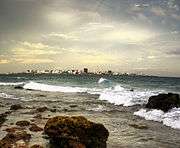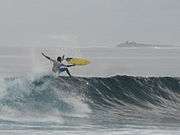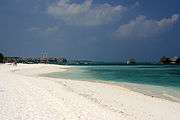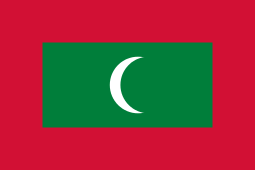Kaafu Atoll
| Kaafu Atoll | |
|---|---|
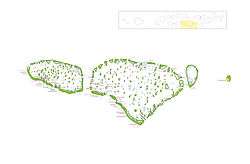 | |
| Country | Maldives |
| Corresponding geographic atoll(s) | Malé Atoll |
| Location | 4°25′N 73°30′E / 4.417°N 73.500°ECoordinates: 4°25′N 73°30′E / 4.417°N 73.500°E |
| Capital | Thulusdhoo |
| Government | |
| • Atoll chief | Mohamed Adam[1] |
| Population | |
| • Total | 12,166 |
| Letter code | H |
| Dhivehi letter code | K (ކ) |
| • Number of islands | 107 |
| • Inhabited islands | Dhiffushi * Gaafaru * Gulhi * Guraidhoo * Himmafushi * Huraa * Kaashidhoo * Maafushi * Thilafushi * Thulusdhoo |
| • Uninhabited islands | Aarah, Akirifushi, Asdhoo, Baros, Bandos, Biyaadhoo, Bodubandos, Bodufinolhu, Boduhithi, Boduhuraa, Bolifushi, Dhigufinolhu, Dhoonidhoo, Ehrruh-haa, Enboodhoo, Enboodhoofinolhu, Eriyadhoo, Farukolhufushi, Feydhoofinolhu, Fihalhohi, Funadhoo, Furan-nafushi, Gasfinolhu, Giraavaru, Girifushi, Gulheegaathuhuraa, Helengeli, Henbadhoo, Huraagandu, Ihuru, Kagi, Kalhuhuraa, Kandoomaafushi, Kanduoih-giri, Kanifinolhu, KKanuhuraa, Kudabandos, Kudafinolhu, Kudahithi, Kudahuraa, Lankanfinolhu, Lankanfushi, Lhohifushi, Lhosfushi, Maadhoo, Madivaru, Mahaanaélhihuraa, Makunudhoo, Makunufushi, Maniyafushi, Medhufinolhu, Meerufenfushi, Nakachchaafushi, Olhahali, Olhuveli, Oligandufinolhu, Ran-naalhi, Rasfari, Thanburudhoo, Thulhaagiri, Vaadhoo, Vaagali, Vabbinfaru, Vabboahuraa, Vammaafushi, Velassaru, Velifaru, Veliganduhuraa, Vihamanaafushi, Villingilimathidhahuraa, Villingilivau, Ziyaaraiffushi |
| Resort islands, airports and industrial islands are also considered uninhabited. | |
Kaafu Atoll (also known as Malé Atholhu) is an administrative division of the Maldives. It consists of Kaashidhoo Island, Gaafaru, and Malé Atoll (which includes the North Malé Atoll and the South Malé Atoll). It also has a number of uninhabited islands. Its capital is Thulusdhoo.
Malé, capital of the Maldives is naturally located within the North Malé Atoll, but it is not part of the Kaafu administrative division.
NOTE: Haa Alifu, Haa Dhaalu, Shaviyani, Noonu, Raa, Baa, Kaafu, etc. are code letters assigned to the present administrative divisions of the Maldives. They are not the proper names of the natural atolls that make up these divisions. Some atolls are divided into two administrative divisions while other divisions are made up of two or more natural atolls. The order followed by the code letters is from North to South, beginning with the first letters of the Thaana alphabet used in Dhivehi. These code letters are not accurate from the geographical and cultural point of view. However, they have become popular among tourists and foreigners in the Maldives who find them easier to pronounce than the true atoll names in Dhivehi, (save a few exceptions, like Ari Atoll).[2]
Uninhabited islands
Although uninhabited, some islands of the atoll have commercial uses. These include
- Baros which was previously inhabited and abandoned only during the reign of Sultan Hassan Nooraddeen I for unknown reasons. It is now the home of the Baros Island Resort.[3]
- Bodu Hithi which houses a 5-star Coco Palm resort.[4]
- Dhoonidhoo which houses a detention unit.[5]
- Farukolhufushi which housed a Club Med until the tsunami on December 26, 2004. Another resort named Club Faru[6] opened here around the end of 2005.
- Ihuru on which is located a Maldivian 4 star resort, the "Angsana Resort and Spa Maldives"
- Kanifinolhu which houses a Club Med village (Club Med Kani),[7] the only one on the atoll since the Club Med Faru on Farukolhufushi was destroyed.
- Lankanfinolhu which has been home to a tourist-resort called Paradise Island Resort[8] since 1979.
- Dhigufinolhu which has housed a 5-star Maldivian resort, Anantara Dhigu Resort and Spa,[9] since September 2006.
- Vihamanafushi was the first Island in the Maldives to be developed for Tourism, now called Kurumba Maldives being a 4.5 star Resort.[10]
Gallery
|
References
- ↑ "Head of Atolls (Atoll Chiefs)". Ministry of Atolls Development. Archived from the original on 2008-09-15. Retrieved 2012-04-18.
- ↑ Tim Godfrey, Atlas of the Maldives, Atoll Editions 2004
- ↑ "Baros Maldives". Retrieved 2012-04-18.
- ↑ "Bodu Hithi s". Coco Palms Resort. 2009-08-10. Retrieved 2012-04-18.
- ↑ "Maldives: Renewed repressive measures against the opposition" (PDF). Amnesty International. 28 November 2006. Retrieved 2012-04-18.
- ↑ amridesign.com. "Club Faru". Club Faru. Retrieved 2012-04-18.
- ↑ "Resort : Kani (Maldives), The Resort". Club Med. Retrieved 2012-04-18.
- ↑ "Paradise Island Resort and Spa, Paradise Island Maldives". Maldives Tourism. Retrieved 2012-04-18.
- ↑ "Anantara Dhigu Resort & Spa Maldives". Anantara Dhigu Resort & Spa Maldives. Retrieved 2012-04-18.
- ↑ "Kurumba Maldives since October 1972.".
- Divehi Tārīkhah Au Alikameh. Divehi Bahāi Tārikhah Khidmaiykurā Qaumī Markazu. Reprint 1958 edn. Malé 1990.
- Divehiraajjege Jōgrafīge Vanavaru. Muhammadu Ibrahim Lutfee. G.Sōsanī.
- Xavier Romero-Frias, The Maldive Islanders, A Study of the Popular Culture of an Ancient Ocean Kingdom. Barcelona 1999.

